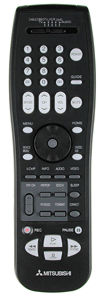Mitsubishi WS-73711 73-Inch HDTV Page 2
 The set's only real drawback occurs when its internal processor loses a film source's 3:2 frame sequence and switches to video, which causes moving images to look extremely jagged. Once the processor determines if the source is video or film, it handles the image nicely. It's during that brief instant in between that you might notice a problem. This is significant during commercial breaks or in documentaries that regularly switch from film to video.
The set's only real drawback occurs when its internal processor loses a film source's 3:2 frame sequence and switches to video, which causes moving images to look extremely jagged. Once the processor determines if the source is video or film, it handles the image nicely. It's during that brief instant in between that you might notice a problem. This is significant during commercial breaks or in documentaries that regularly switch from film to video.
Another nitpick is that dark objects on the left side of the WS-73711's screen create a faint horizontal streak across brighter objects to the right. This is easy to see with test patterns but rarely reveals itself with regular video. You should spend a few moments in the store checking out different images to see if you notice it.
Last but not least, I tested the set's resolution. Both DVD and HD images are razor-sharp—so sharp, in fact, that a 480p signal's scan lines are clearly visible. The set would benefit from a scaler that upconverts NTSC signals to, say, 600p. The output from our generator indicates that the set is capable of resolving about 1,550 to 1,600 of the 1,920 horizontal pixels in a 1080i signal. This is more than enough for DVD signals, but some people might find it to be less than adequate for true HDTV. However, few if any true HDTV sources even broadcast a full 1,920-pixel signal. As far as I know, Mark Cuban's HDNet is the only source that claims to do so. Last I heard, the signal from major broadcasters was limited to about 1,500 pixels, while DirecTV and Dish Network only offer about 1,200.
So, how does the WS-73711's performance compare with that of other sets? I don't really know yet. I can tell you that our reference Runco front projector, the DTV-991, which uses 8-inch CRTs (with a more-advanced focusing system), is just barely capable of resolving the full 1,920:1080i sig-
nal. This is a $30,000 projector. Relatively speaking, the Mitsubishi does fairly well. I don't expect many, if any, 7-inch-CRT projectors to do much better, and the current crop of DLP projectors is limited to their chip's native resolution of 1,280:720.
All in all, the WS-73711 is a good television. At the very least, it's a huge one. The set has a few quirks, and you'll want to see if they bother you before you take one of these big boys home. You should also consider having the set professionally tweaked by a qualified technician. If you do, you'll be blown away by how sharp and colorful the WS-73711 is.

Highlights
• Razor-sharp picture
• More inputs than
many receivers
• Built-in HD tuner with
IEEE 1394 connectors
- Log in or register to post comments




































































